Global Antihistamine Drugs Market Size and Trends
The antihistamine drugs market is estimated to be valued at USD 101.74 Bn in 2025 and is expected to reach USD 167.80 Bn by 2032, growing at a compound annual growth rate (CAGR) of 7.4% from 2025 to 2032.
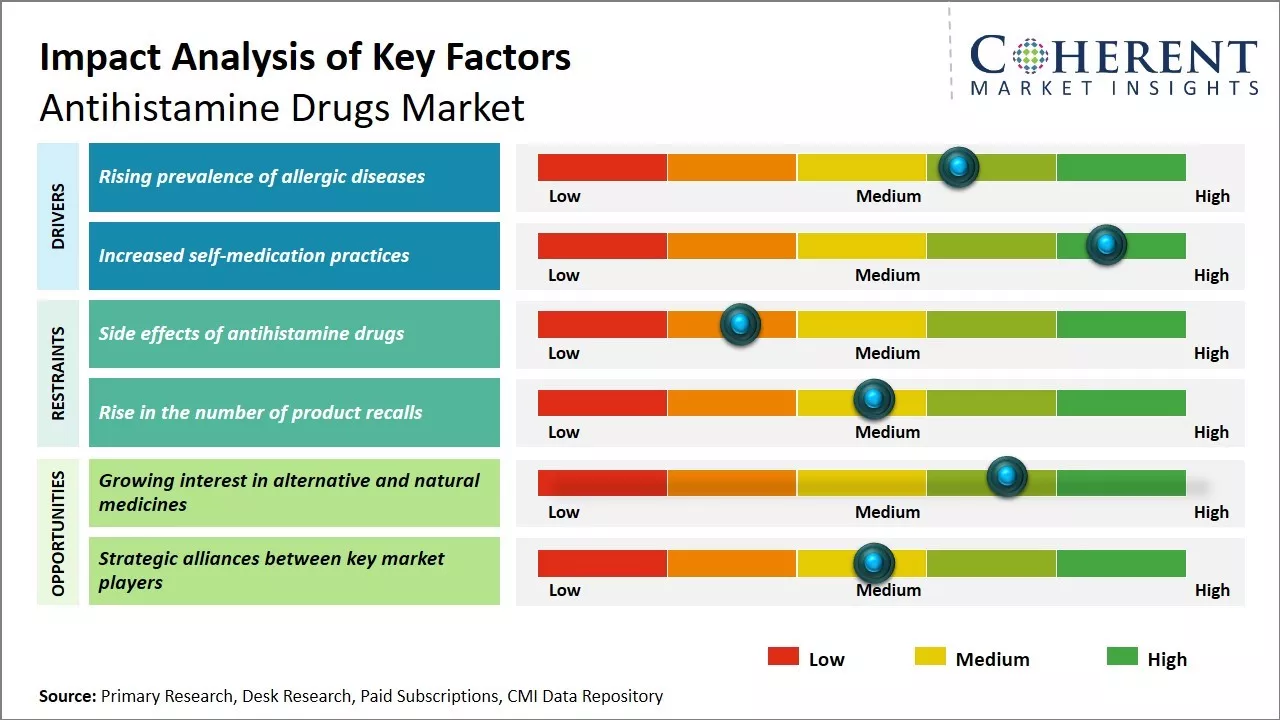
Discover market dynamics shaping the industry: Download Free Sample
The antihistamine drugs market has been witnessing a growing trend of development of advanced formulations. Traditionally, antihistamine drugs were available in the form tablets and capsules. However, consumption of tablets and capsules requires water, which may not always be available, especially in outdoor activities involving allergy sufferers.
To overcome this limitation, market players are focusing on developing advanced formulations such as sprays, creams and wipes to provide convenience of use. This has been a major trend revolutionizing use of antihistamines. Development of advanced formulations is expected to drive future growth opportunities in antihistamine drugs market over the forecasted period.
Rising prevalence of allergic diseases
The global prevalence of allergic diseases and disorders has been increasing significantly over the past few decades. Allergic rhinitis, commonly known as hay fever, is a very common medical condition that affects both children and adults. It occurs when the immune system overreacts to allergens in the air like pollen, dust mites, pet dander, or mold. According to an article published by the European government in July 2022, about 150 million people in Europe live with an allergic condition, such as allergic rhinitis, asthma, atopic eczema, or a food allergy. The growing environmental pollution and changes in lifestyle and diet are believed to be major factors contributing to the heightened risk of developing allergic conditions. As antihistamine drugs are currently the most effective pharmacological treatment for relieving symptoms of allergies like sneezing, itchy and watery eyes, it is expected that the rising disease prevalence will drive steady demand for these medications in the coming years.
Market Concentration and Competitive Landscape
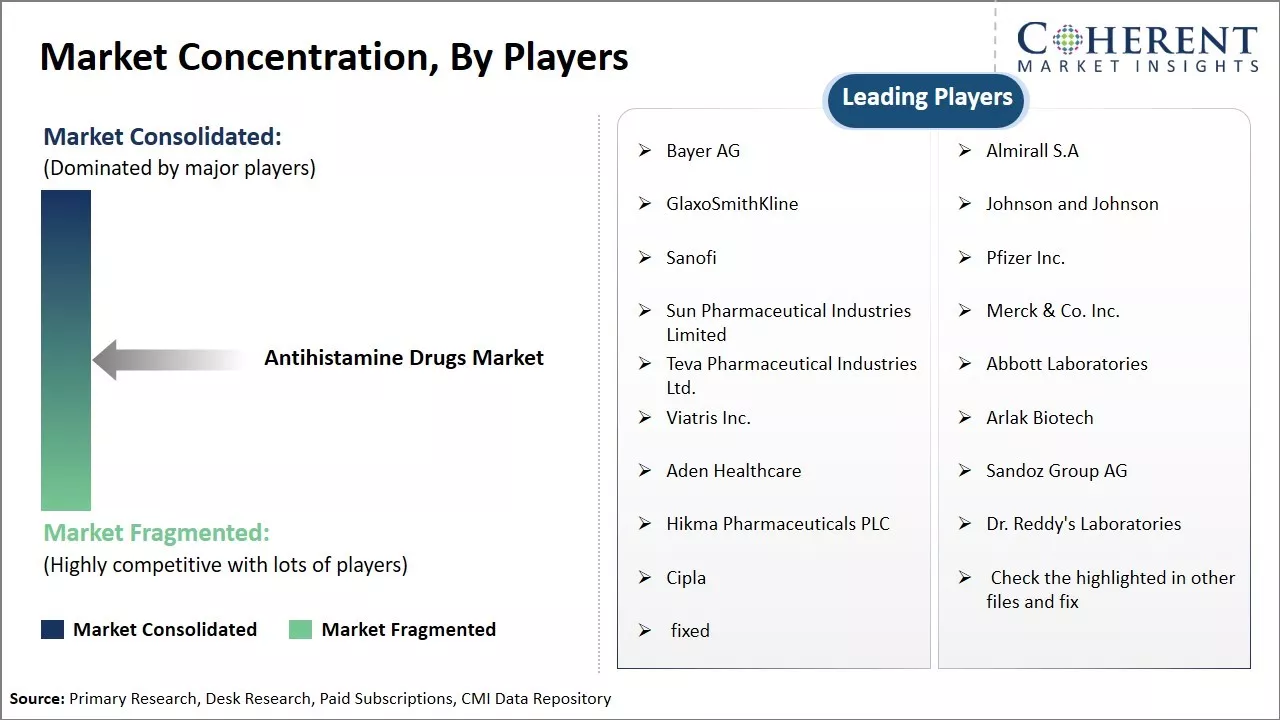
Get actionable strategies to beat competition: Download Free Sample
Increased self-medication practices
Another important driver for the antihistamine drugs market is the trend of self-medication becoming more common among the general public. With easy over-the-counter availability of many common anti-allergy medications without a prescription, people experiencing mild to moderate allergy symptoms often prefer to treat themselves first before seeking medical help. Wide promotion of antihistamine brands directly to consumers through various online and offline advertising campaigns has raised awareness about minor allergy problems and treatment options. This encourages more individuals to reach for an over-the-counter (OTC) antihistamine and try to alleviate their symptoms on their own rather than booking a doctor's appointment. According to an article published in July 2023 by the National Center for Biotechnology Information, a branch of the National Institutes of Health, antihistamines accounted for 13.4% of the total self-medication drugs among the rural population of Tamil Nadu, India.
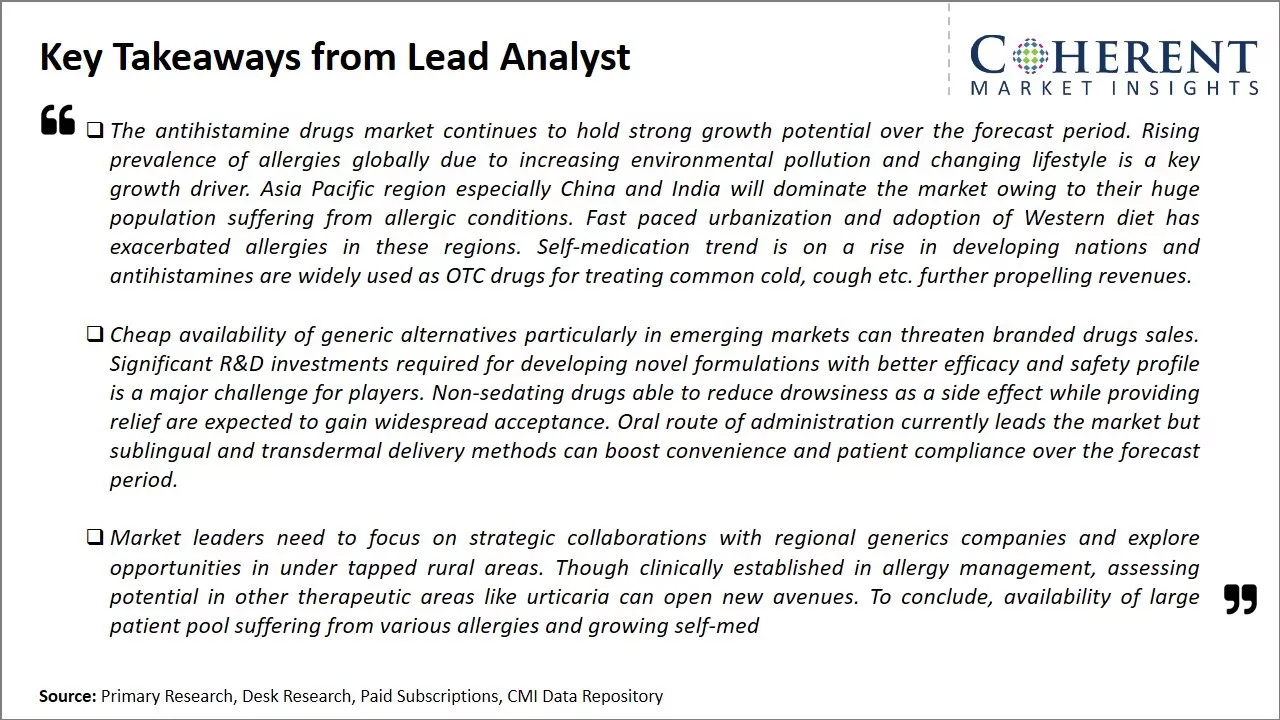
To learn more about this report, Download Free Sample
Market Challenges – Side effects of antihistamine drugs:
One of the major factors restraining the growth of the antihistamine drugs market is the prevalence of side effects associated with these medications. Many first-generation antihistamines, such as diphenhydramine (Benadryl), are known to cause drowsiness as a common side effect due to their sedative properties. This sedative effect can negatively impact performance at work or school and daily activities requiring alertness like driving. The drowsiness caused by these medications can be severe enough to impair functioning.
Market Opportunities - Growing interest in alternative and natural medicines:
Pipeline drugs for novel indications represent a promising opportunity in the antihistamine drugs market. Antihistamines have traditionally been used for treating allergic conditions like hay fever, hives, and respiratory allergies by blocking the effects of histamine in the body. However, with ongoing research and clinical trials, several antihistamines are now being explored for new therapeutic uses beyond their conventional allergy applications.
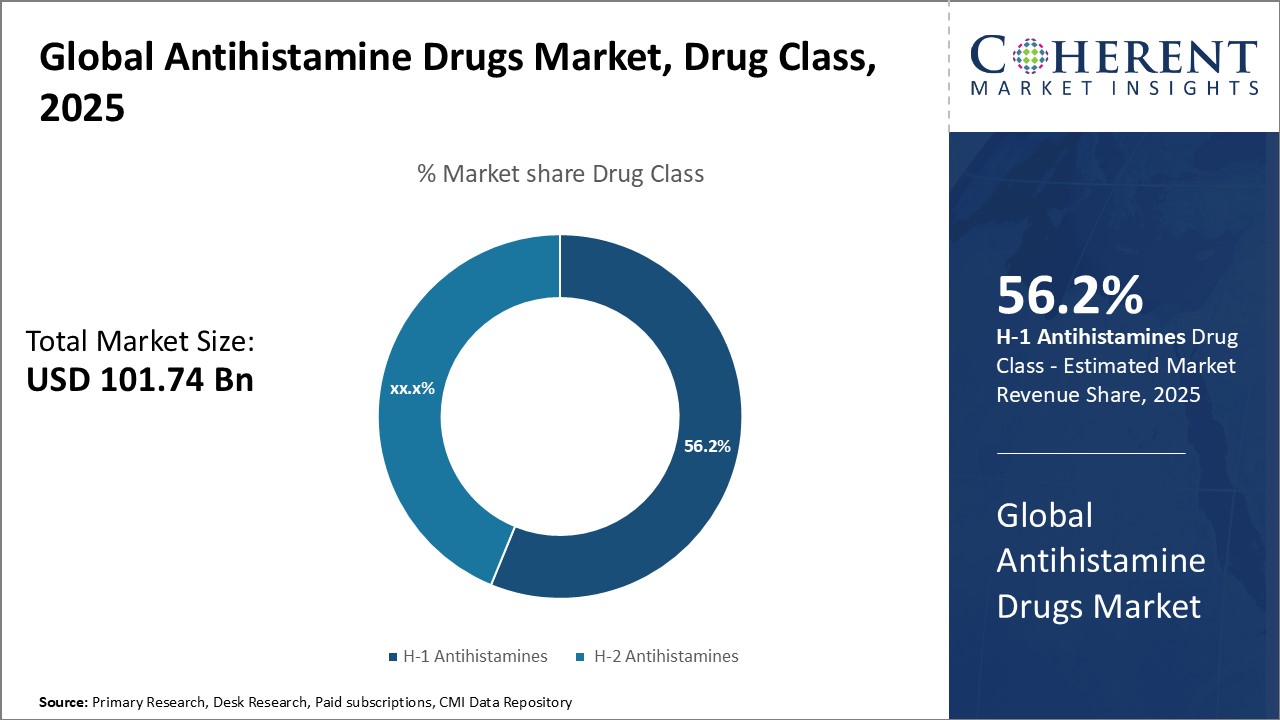
Discover high revenue pocket segments and roadmap to it: Download Free Sample
Insights, By Drug Class: Increased Allergic Reactions Drive Growth in H-1 Antihistamines growth
The drug class segment includes H-1 antihistamines and H-2 antihistamines. In terms of drug class, H-1 antihistamines H-1 antihistamines work by blocking the effects of histamine, which the body produces during an allergic reaction. As more people suffer from allergies such as hay fever, dust mites, pet dander and food allergies, the demand for H-1 antihistamines has increased substantially. Moreover, new product launches with improved formulations and fewer side effects have boosted preference for H-1 drugs over H-2 alternatives. The availability of generic versions of popular H-1 brands at lower costs has further accelerated their uptake. The development of non-sedating varieties has increased compliance for long-term usage. Advanced formulations that provide 24-hour relief with single daily dosing are also driving repeat sales. Overall, the growing allergy epidemic and improved product attributes have facilitated H-1 antihistamines' dominance in the drug class segment.
Insights, By Form: Easy to consume drives tablets development
The form segment includes liquid, tablets, capsules, gels, nasal sprays, and others. In terms of form, tablets segment is projected to have 30.2% of the market share in 2025. Being solid oral dosage forms, tablets are easy to carry, stable and preserve drug properties without any special packaging or temperature controls. They are also perceived as more familiar, discrete and easier to consume compared to alternative forms. Furthermore, tablets often allow for modified or controlled release designs that increase patient compliance with dosage instructions. This is a critical factor considering antihistamines require long-term use. Liquid forms face challenges such as measuring doses accurately and dealing with unpleasant tastes. Gels and sprays are viewed as messier options suitable only for selective conditions. Given tablets' inherent benefits coupled with the emerging need for all-day allergy relief, they have emerged as the most adopted form for antihistamine consumption.
Insights, By Indication: Prevalence of Allergic Disorders
The indication segment consists of allergic disorders, gastrointestinal disorders, central nervous system disorders, dermatological disorders, and others. In terms of indication, allergic disorders segment is anticipates to have 34.3% of the market share in 2024. There is growing evidence that environmental changes and modern lifestyles have aggravated allergy-causing factors such as air pollution and indoor allergens. Similarly, dietary and microbiota changes are fueling food allergies. As per research, over 50% of the global population suffers from some form of allergy. Antihistamines are usually the first line treatment for relieving symptoms and enabling quality of life. Their usage is highly compatible with long-term management of disorders lacking definitive curative options. Even as antihistamines explore new therapeutic areas, allergic disorders will drive a bulk of overall volume owing to factors exacerbating their prevalence worldwide. This makes allergic disorders a highly remunerative application segment for antihistamine suppliers.
Insights, By Type: Accessibility Drives OTC Segment Growth
The type segment includes OTC and prescription. In terms of type, OTC segment is projected to have 56.4% of the market share in 2025. Patients prefer OTC antihistamine drugs as they do not require a prescription and can purchase them directly from retail stores. This allows individuals to conveniently treat common allergy and cold symptoms without needing to schedule an appointment with a physician. The self-care nature of OTC antihistamines appeals to busy consumers with minor health issues that do not necessitate a doctor's involvement. Furthermore, OTC drugs are generally lower in cost than prescription medications due to the absence of medical consultation fees. Individuals can discreetly purchase OTC antihistamines as needed without others knowing about their health condition. The wide availability of these products on pharmacy and online retail shelves boosts their volume sales and market shareover prescription options. Manufacturers also aggressively promote OTC antihistamines through marketing campaigns highlighting advantages like easy access and affordability. Overall, the convenient accessibility drives consistent consumer demand for OTC antihistamine drugs.
Insights, By Route of Administration: Ease of administration drives oral segments growth
The route of administration segment includes oral, parenteral, and others. In terms of route of administration, the oral segment is estimated to have 40.3% of the market share in 2025. Antihistamine tablets and capsules are effortless for patients to swallow compared to other delivery forms like injections. Most individuals feel more comfortable ingesting drugs orally instead of receiving shots. The oral route also enables dosing flexibility where patients can take medication on an as-needed basis. This allows treating intermittent symptoms from allergies or colds that flare up occasionally. Manufacturers facilitate patient adherence by offering oral antihistamines in convenient daily formulations. The swallow able design provides discreet consumption without others seeing the method of drug intake. Furthermore, oral antihistamines maintain stable drug levels in the body after ingestion compared to short-acting injections. Their sustained release prevents frequent re-dosing and improves symptom management throughout the day. Overall, the user-friendly nature and flexibility of oral administration fuel its popular use over parenteral or other alternatives.
Regional Insights
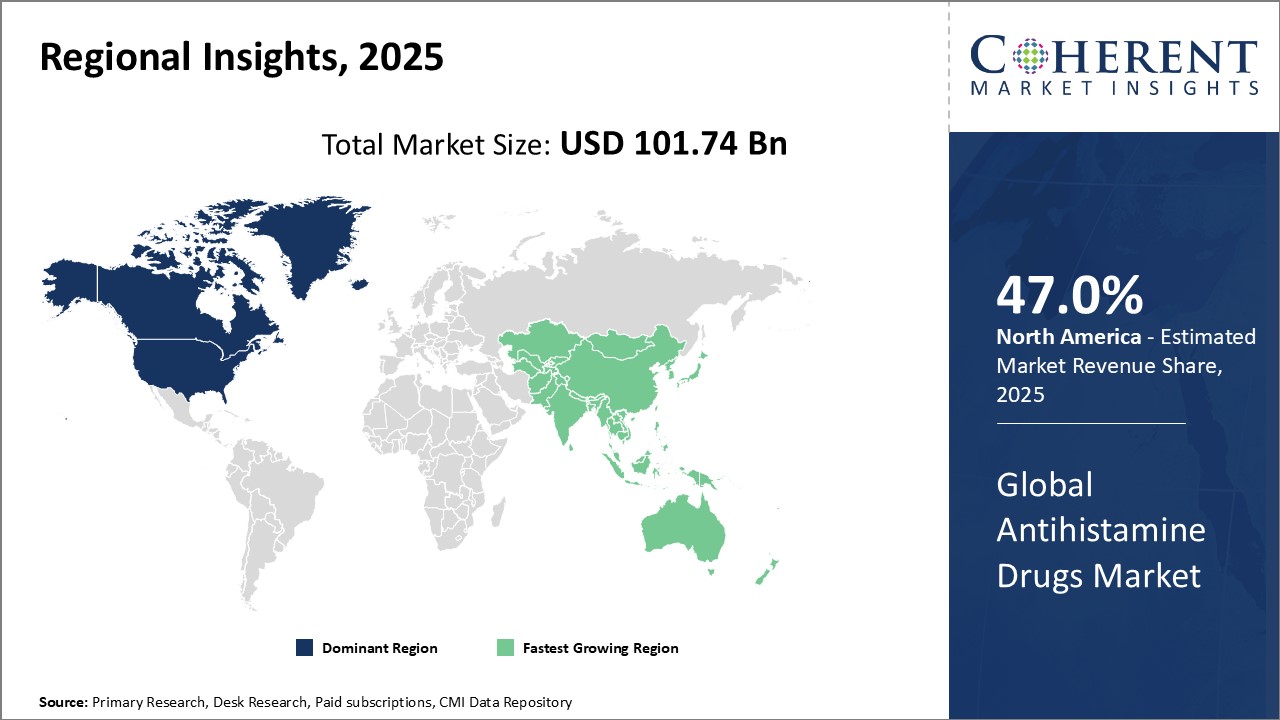
Need a Different Region or Segment? Download Free Sample
North America is anticipated to have the highest share i.e., 47.0% of the market in 2025 owing to strong presence of leading pharmaceutical companies and established healthcare infrastructure in countries like the U.S. and Canada. The presence of well-developed economies, advanced healthcare systems and rising affordability has made North America an attractive market for international players to invest in research and development of novel antihistamine drugs. The U.S. in particular accounts for over 40.5% of the global antihistamine drugs sales, driven by factors such as high prescription rates and availability of various branded and generic formulations across retail pharmacies and hospitals.
Asia Pacific has emerged as the fastest-growing regional market for antihistamine drugs in recent years. The rise of Asia Pacific is chiefly attributed to increasing healthcare expenditure, rapid economic growth, growing medical needs of expanding middleclass in countries like India and China. Additionally, relatively lower manufacturing and research costs compared to developed nations have attracted Pharma giants to establish manufacturing facilities for antihistamine drugs in the region. The international pharmaceutical companies have also entered partnerships and licensing agreements with local generic drug makers to penetrate emerging Asia Pacific markets. Countries like India and China dominate Asia Pacific’s antihistamine drugs market. Rapid aging population and growth of medical tourism industry has boosted consumption of antihistamine drugs in China as allergies and other related conditions are on the rise. Overall, factors like growing patient pool, improving access and affordability are driving the antihistamine drugs market across both India and China at an impressive pace.
Market Report Scope
Global Antihistamine Drugs Market Report Coverage
| Report Coverage | Details | ||
|---|---|---|---|
| Base Year: | 2024 | Market Size in 2025: | USD 101.74 Bn |
| Historical Data for: | 2020 To 2024 | Forecast Period: | 2025 To 2032 |
| Forecast Period 2025 to 2032 CAGR: | 7.4% | 2032 Value Projection: | USD 167.80 Bn |
| Geographies covered: |
|
||
| Segments covered: |
|
||
| Companies covered: |
Bayer AG, Almirall S.A, GlaxoSmithKline, Johnson and Johnson, Sanofi, Pfizer Inc., Sun Pharmaceutical Industries Limited, Merck & Co. Inc., Teva Pharmaceutical Industries Ltd., Abbott Laboratories, Viatris Inc., Arlak Biotech, Aden Healthcare, Sandoz Group AG, Hikma Pharmaceuticals PLC, Dr. Reddy's Laboratories, and Cipla |
||
| Growth Drivers: |
|
||
| Restraints & Challenges: |
|
||
Uncover macros and micros vetted on 75+ parameters: Get instant access to report
Market Segmentation
- Drug Class Insights (Revenue, USD Bn, 2020 - 2032)
- H-1 Antihistamines
- First-generation
- Second-generation
- H-2 Antihistamines
- H-1 Antihistamines
- Form Insights (Revenue, USD Bn, 2020 - 2032)
- Liquid
- Tablets
- Capsules
- Gels
- Nasal Sprays
- Others
- Indication Insights (Revenue, USD Bn, 2020 - 2032)
- Allergic Disorders
- Gastrointestinal Disorders
- Central Nervous System Disorders
- Dermatological Disorders
- Others
- Route Of Administration Insights (Revenue, USD Bn, 2020 - 2032)
- Oral
- Parenteral
- Others
- Type Insights (Revenue, USD Bn, 2020 - 2032)
- OTC
- Prescription
- Distribution Channel Insights (Revenue, USD Bn, 2020 - 2032)
- Hospital Pharmacies
- Retail Pharmacies
- Online Pharmacies
- Regional Insights (Revenue, USD Bn, 2020 - 2032)
- North America
- U.S.
- Canada
- Latin America
- Brazil
- Argentina
- Mexico
- Rest of Latin America
- Europe
- Germany
- U.K.
- Spain
- France
- Italy
- Russia
- Rest of Europe
- Asia Pacific
- China
- India
- Japan
- Australia
- South Korea
- ASEAN
- Rest of Asia Pacific
- Middle East
- GCC Countries
- Israel
- Rest of Middle East
- Africa
- South Africa
- North Africa
- Central Africa
- North America
- Key Players Insights
- Bayer AG
- Almirall S.A
- GlaxoSmithKline
- Johnson and Johnson
- Sanofi
- Pfizer Inc.
- Sun Pharmaceutical Industries Limited
- Merck & Co. Inc.
- Teva Pharmaceutical Industries Ltd.
- Abbott Laboratories
- Viatris Inc.
- Arlak Biotech
- Aden Healthcare
- Sandoz Group AG
- Hikma Pharmaceuticals PLC
- Dr. Reddy's Laboratories
- Cipla
Share
Share
About Author
Ghanshyam Shrivastava - With over 20 years of experience in the management consulting and research, Ghanshyam Shrivastava serves as a Principal Consultant, bringing extensive expertise in biologics and biosimilars. His primary expertise lies in areas such as market entry and expansion strategy, competitive intelligence, and strategic transformation across diversified portfolio of various drugs used for different therapeutic category and APIs. He excels at identifying key challenges faced by clients and providing robust solutions to enhance their strategic decision-making capabilities. His comprehensive understanding of the market ensures valuable contributions to research reports and business decisions.
Ghanshyam is a sought-after speaker at industry conferences and contributes to various publications on pharma industry.
Missing comfort of reading report in your local language? Find your preferred language :
Transform your Strategy with Exclusive Trending Reports :
Frequently Asked Questions
EXISTING CLIENTELE
Joining thousands of companies around the world committed to making the Excellent Business Solutions.
View All Our Clients
